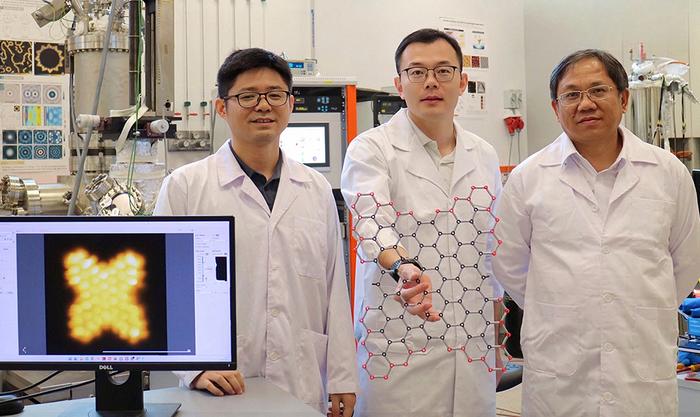Researchers from the National University of Singapore (NUS) have discovered a new design concept for creating next-generation carbon-based quantum materials, a tiny magnetic nanographene with a unique butterfly-shape hosting highly correlated spins, demonstrating potential for advancements in quantum information technologies.

Credit: National University of Singapore
Researchers from the National University of Singapore (NUS) have discovered a new design concept for creating next-generation carbon-based quantum materials, a tiny magnetic nanographene with a unique butterfly-shape hosting highly correlated spins, demonstrating potential for advancements in quantum information technologies.
Magnetic nanographene, a tiny structure made of graphene molecules, exhibits remarkable magnetic properties due to the behaviour of specific electrons in the carbon atoms’ π-orbitals. Unlike conventional magnetic materials produced using heavy metals, where the different types of electrons from d- or f-orbitals are involved, carbon’s π-electrons play a unique role. By precisely designing the arrangement of these carbon atoms at the nanoscale, control over the behaviour of these unique electrons can be achieved. This renders nanographene highly promising for creating extremely small magnets and for fabricating the basic components, known as quantum bits or qubits, essential for the development of quantum computers. High-quality qubits need to maintain their quantum state for an extended duration known as coherence time while operating quickly. Carbon-based materials are known to extend the coherence times of spin qubits, due to their two unique properties: weak spin-orbit and hyperfine couplings that effectively prevent decoherence of electron spins.
The team of researchers led by Associate Professor LU Jiong from the NUS Department of Chemistry and Institute for Functional Intelligent Materials, together with Professor Jishan WU also from the NUS Department of Chemistry, and international collaborators, have developed a method for designing and creating a large fully-fused butterfly-shaped magnetic nanographene. This unique structure has four rounded triangles resembling butterfly wings, with each of these wings holding an unpaired π-electron responsible for the observed magnetic properties. This accomplishment is attributed to the atomic-precise design of the π-electron network in the nanostructured graphene.
Assoc Prof Lu said, “Magnetic nanographene, a tiny molecule composed of fused benzene rings, holds significant promise as a next-generation quantum material for hosting fascinating quantum spins due to its chemical versatility and long spin coherence time. However, creating multiple highly entangled spins in such systems is a daunting yet essential task for building scalable and complex quantum networks.”
This significant achievement stems from a close collaboration among synthetic chemists, materials scientists, and physicists, including key contributors Professor Pavel Jelinek and Dr Libor Vei, both from the Czech Academy of Sciences in Prague.
The research breakthrough was published in the scientific journal Nature Chemistry on 19 Feb 2024.
A new-generation magnetic nanographene with highly-entangled spins
The magnetic properties of nanographene are usually derived from the arrangement of its special electrons, known as π-electrons, or the strength of their interactions. However, it is difficult to make these properties work together to create multiple correlated spins. Also, nanographene predominately exhibits a singular magnetic order, where spins align either in the same direction (ferromagnetic) or in opposite directions (antiferromagnetic).
The researchers developed a new kind of magnetic nanographene to overcome these challenges. They created a nanographene, with both ferromagnetic and antiferromagnetic properties, that has a butterfly shape, made by combining four smaller triangles into a rhombus at the centre, measuring approximately 3 nanometres in size.
To produce this butterfly nanographene, the researchers initially designed a special molecule precursor via conventional in-solution chemistry. This precursor was then used for the subsequent on-surface synthesis, a new type of solid-phase chemical reaction performed in a vacuum environment. This approach allowed the researchers to precisely control the shape and structure of the nanographene at the atomic level.
An intriguing aspect of this butterfly nanographene is that it has four unpaired π-electrons, with spins mainly delocalised in the “wing” regions and entangled together. Using an ultra-cold scanning probe microscope with nickelocene tip as an atomic-scale spin sensor, the researchers measured the exotic magnetism of the butterfly nanographenes. Additionally, this new technique helps scientists in directly probing entangled spins to understand how the nanographene’s magnetism works at the atomic-scale. This breakthrough not only tackles existing challenges but also opens up new possibilities for precisely controlling the magnetic properties at the smallest scale, leading to exciting advancements in quantum materials research.
“The insights gained from this study pave the way for creating new-generation organic quantum materials with designer quantum spin architectures. Looking ahead, our goal is to measure the spin dynamics and coherence time at the single-molecule level and manipulate these entangled spins coherently. This represents a significant stride towards achieving more powerful information processing and storage capabilities,” added Assoc Prof Lu.
Journal
Nature Chemistry
Method of Research
Experimental study
Subject of Research
Not applicable
Article Title
Highly-Entangled Polyradical Nanographene with Coexisting Strong Correlation and Topological Frustration
Article Publication Date
19-Feb-2024



